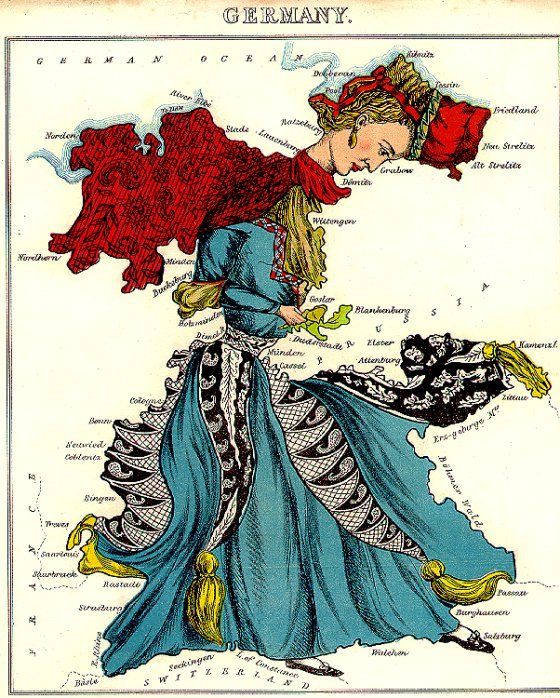Strangest Maps Ever Created – You Have Never Seen Our World Like This!
Conny Waters - AncientPages.com - In ancient times, people saw the world in a very different way. This collection of maps must be one of the strangest representations of world depictions ever created.
Some of these maps are fantasy. As you can see, the shapes of the countries and continents are odd representations of figures or animals. Other maps depict what our ancestors believed to be Biblical Lands.
“Legends of strange human beings have a long history, as do their depictions on maps. Many of these representations were derived from the descriptions given in the Natural History of the World by the elder Pliny (AD 23-79) and first printed in Latin in 1469. Pliny’s ideas were absorbed by most geographers of the 16th century and were particularly well illustrated in the successive editions of Ptolemy’s maps published by Sebastian Munster from 1540 onwards.
On the Ptolemaic map of Asia, a number of strange beings are placed in Scythia or part of Northern Asia.
At the top of the map, Munster shows the Anthropophagi, who feed on men’s flesh and live near the North Pole.
In the margins he depicts those humans described by Pliny in Book 7:
“In India there is a kind of men with heads like dogs…who in lieu of speech use to bark.
Likewise there is a kind of people named monoscelli that have but one leg apiece.
In the hottest season of Summer, they lie along their backs and defend themselves with their foot against the Sunnes heat.”
Then of course we have the legendary Garden of Eden. For over 1500 years the existence of the Garden of Eden was an unquestionable fact for most Christian believers. Its location varied, but in the early Middle Ages, it was generally thought to be at the eastern extremity of the world, while later it was placed in the area of Mesopotamia.
Islandia. From the Theatrum Orbis Terrarum of Abraham Ortelius. Antwerp, c. 1585. Credit: Yale University
Early mapmakers often recorded on their maps and charts the presence of fabulous beasts, many of which reveal themselves as identifiable species made grotesque by the embroidered tales of sailors and travelers. Of the many maps depicting sea monsters, the Carta Marina by Olaus Magnus was the most influential. First printed in 1539, it showed the area of the North Sea filled with dangerous maritime creatures. Versions of Olaus Magnus’s monsters populated the seas on charts until the mid-18th century.
Ortelius copied many of these monsters for his map of Iceland, published in editions of his Theatrum Orbis Terrarum. Iceland is shown at a large scale, with its fjords, glaciers, and mountains, including an erupting volcano, Mt. Hekla. Polar bears on icebergs can be seen at the top right, while the ocean contains probably the most fantastic collection of sea monsters to be seen on one engraving.
Asia Secunda Pars Terrae in Forma Pegasir. Die Gantze Welt in ein Kleberblat. Heinrich Bunting, c. 1590. Credit: Yale University
Among the earliest cartographic oddities are the famous maps from Heinrick Bunting’s Itinerarium Sacra Scripturae, or Travels According to the Scriptures, first published in 1581. A description of Biblical lands, it was a popular book that was reprinted many times. In addition to correct maps of the Holy Land, it also contained three maps of pure fantasy: the world in the form of a clover leaf, Europe as a robed female figure, and Asia as Pegasus the mythical winged horse.
Credit: Yale University
The horse is drawn fairly realistically so that the shape of Asia has to be adjusted; the Caspian Sea lies horizontally between the wings and the saddle, and modern India is the off hind leg. The Pegasus map can be found in a number of different editions in both woodcut (as displayed here) and more rare copperplate versions.
In Bunting’s map of the world as a clover leaf, representing the Trinity, each of the three continents of the Old World forms a section, with Jerusalem in a circle in the center. England and Scandinavia appear separately at the northern edge of the map, and the new continent of America can be seen in the lower left corner.
Credit: Yale University
It has been suggested that the cloverleaf design represents not only the Trinity but the arms of Bunting’s native city of Hanover.
These maps are from Geographical Fun, or Humorous Outlines of Various Countries, published by Hodder and Stoughton in 1869. The author, William Harvey writing under the pseudonym Aleph, created a series of twelve maps showing various countries as curious people in the great tradition of English caricaturists. The idea behind the maps was taken from sketches drawn by a fifteen-year-old girl wishing to amuse her sick brother confined to bed.
Harvey states in the introduction: “It is believed that illustrations of Geography may be rendered educational, and proof of service to young scholars who commonly think Globes and Maps but wearisome aids to knowledge.” The maps and rhymes were thus designed to amuse children and to teach some basic geographical concepts, rather than as political satires.
These maps are part of the Yale University Map Collection.
Written by Conny Waters - AncientPages.com Staff Writer
More From Ancient Pages
-
 Neanderthals Had Capacity To Speak And Understand Language Like Humans
Archaeology | Mar 2, 2021
Neanderthals Had Capacity To Speak And Understand Language Like Humans
Archaeology | Mar 2, 2021 -
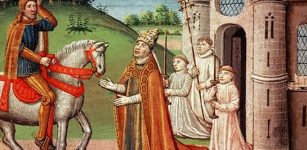 Medieval Warhorses Were Pony-Sized And Much Smaller Than Previously Thought
Archaeology | Jan 11, 2022
Medieval Warhorses Were Pony-Sized And Much Smaller Than Previously Thought
Archaeology | Jan 11, 2022 -
 Lake Huron Was Home To A 9,000-Year-Old Civilization – Underwater Structures And Artifacts Reveal
Archaeology | Jun 17, 2021
Lake Huron Was Home To A 9,000-Year-Old Civilization – Underwater Structures And Artifacts Reveal
Archaeology | Jun 17, 2021 -
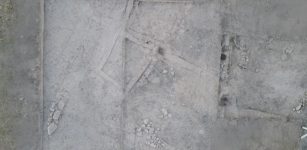 9,600-Year-Old Permament Settlement And Daily Tools Discovered In Turkey
Archaeology | Sep 2, 2022
9,600-Year-Old Permament Settlement And Daily Tools Discovered In Turkey
Archaeology | Sep 2, 2022 -
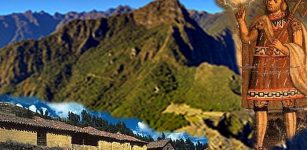 Manco Capac: Legendary Founder Of The Inca Dynasty Of Peru
Featured Stories | Jun 19, 2016
Manco Capac: Legendary Founder Of The Inca Dynasty Of Peru
Featured Stories | Jun 19, 2016 -
 Earliest Version Of Our Alphabet Possibly Discovered
Archaeology | May 17, 2018
Earliest Version Of Our Alphabet Possibly Discovered
Archaeology | May 17, 2018 -
 Surprising Discovery Of Nabataean Underwater Temple In Puteoli, Italy
Archaeology | Sep 23, 2024
Surprising Discovery Of Nabataean Underwater Temple In Puteoli, Italy
Archaeology | Sep 23, 2024 -
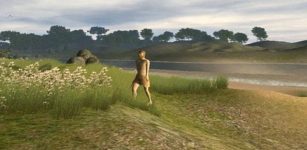 Lost World Of Doggerland: Parts Of Britain’s Sunken Stone Age Atlantis Discovered
Archaeology | Jul 4, 2012
Lost World Of Doggerland: Parts Of Britain’s Sunken Stone Age Atlantis Discovered
Archaeology | Jul 4, 2012 -
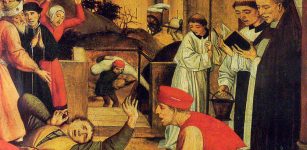 Justinianic Plague Struck England Before It Reached Constantinople And It Did Not Wipe Out The Roman Empire
Archaeology | Nov 19, 2021
Justinianic Plague Struck England Before It Reached Constantinople And It Did Not Wipe Out The Roman Empire
Archaeology | Nov 19, 2021 -
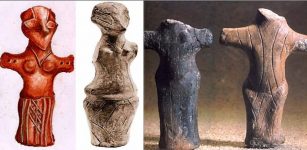 Mysterious Vinca Culture Is Among The Most Advanced Prehistoric Societies In Europe
Civilizations | Jun 23, 2020
Mysterious Vinca Culture Is Among The Most Advanced Prehistoric Societies In Europe
Civilizations | Jun 23, 2020 -
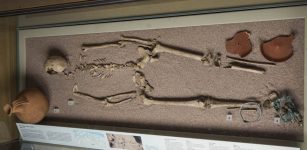 London Was Always A Multicultural City, DNA Research Confirms
Archaeology | Nov 26, 2015
London Was Always A Multicultural City, DNA Research Confirms
Archaeology | Nov 26, 2015 -
 Surtshellir Cave Reveals How Vikings Attempted To Prevent Ragnarök – Doom Of The Gods
Vikings | Jul 17, 2023
Surtshellir Cave Reveals How Vikings Attempted To Prevent Ragnarök – Doom Of The Gods
Vikings | Jul 17, 2023 -
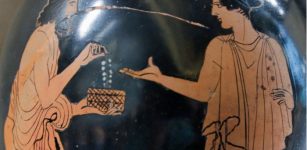 Necklace Of Harmony – Powerful Ill-Fated Piece Of Jewelry With Curse
Featured Stories | Jul 3, 2021
Necklace Of Harmony – Powerful Ill-Fated Piece Of Jewelry With Curse
Featured Stories | Jul 3, 2021 -
 Strange Ancient Measurements Of The Earth Revealed – Ancient Texts And Physical Evidence Examined
Ancient Mysteries | Apr 11, 2018
Strange Ancient Measurements Of The Earth Revealed – Ancient Texts And Physical Evidence Examined
Ancient Mysteries | Apr 11, 2018 -
 Streets Of Ancient Rome Were Very Dangerous
Ancient History Facts | Feb 29, 2016
Streets Of Ancient Rome Were Very Dangerous
Ancient History Facts | Feb 29, 2016 -
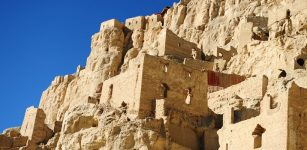 Ruins Of The Mysterious Kingdom Of Guge That Suddenly Vanished Overnight
Civilizations | Apr 10, 2021
Ruins Of The Mysterious Kingdom Of Guge That Suddenly Vanished Overnight
Civilizations | Apr 10, 2021 -
 Egyptian Blue: World’s Oldest Artificial Pigment
Ancient History Facts | Feb 6, 2016
Egyptian Blue: World’s Oldest Artificial Pigment
Ancient History Facts | Feb 6, 2016 -
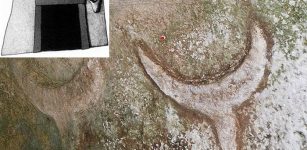 ‘Domus de Janas’ Underground Tombs Dated To 3400-2700 BC And Built By Ozieri Culture On Sardinia
Civilizations | May 12, 2021
‘Domus de Janas’ Underground Tombs Dated To 3400-2700 BC And Built By Ozieri Culture On Sardinia
Civilizations | May 12, 2021 -
 Complex Of Goguryeo Tombs: Beautiful Ancient Wall Paintings Displaying History And Mythology Of North Korea
Civilizations | Oct 19, 2018
Complex Of Goguryeo Tombs: Beautiful Ancient Wall Paintings Displaying History And Mythology Of North Korea
Civilizations | Oct 19, 2018 -
 Cryptic Ice Age Markings In European Caves Deciphered – Proto-Writing Discovered By Amateur Archaeologist
Archaeology | Jan 5, 2023
Cryptic Ice Age Markings In European Caves Deciphered – Proto-Writing Discovered By Amateur Archaeologist
Archaeology | Jan 5, 2023




